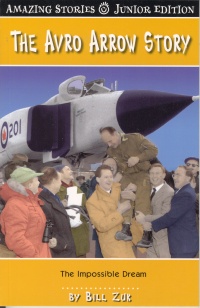| ________________
CM . . .
. Volume XIII Number 11 . . . .January 19, 2007 
 |
The Avro Arrow Story: The Impossible Dream. (Amazing Stories Junior Edition).
Bill Zuk.
Canmore, AB: Altitude Publishing (Distributed by Saunders Book Company), 2006.
96 pp., pbk., $9.95.
ISBN 978-1-55439-703-7.
Grades 4-8 / Ages 9-13.
Review by Thomas F. Chambers.
** /4
|
| |
|

excerpt:
The blaze engulfed the bomber. Crewmen at the forward stations abandoned the aircraft. De Bryne kept trying to wrestle with the controls. Mynarski saw the bailout command but turned back to check on Brophy. He could just make out the tail-gunner. The turret's escape door was jammed, and Brophy was struggling with it. There were flames down the corridor. That didn't stop Mynarski. He tried to help his trapped tail-gunner. Moments later, the fire reached his clothing and parachute. Brophy tried to wave him away, but Mynarski kept hacking at the turret with a fire axe. He even tried to pry it free with his bare hands.
Finally, Mynarski had to quit. He was ablaze from foot to waist. He stood at the escape hatch and saluted his friend. Then he jumped out of the bomber to his death.
The Avro Arrow was a jet fighter designed and built in Canada in the 1950s. It was the fastest and most technically sophisticated plane of its type in the world. As a result, it has achieved a legendary status in Canada. The Avro Arrow Story describes the events leading up to its development and construction, its brief life and destruction.
Author Bill Zuk has impressive credentials for writing a book of this nature. Membership in The Canadian Aviation Historical Society and the Western Canada Aviation Museum show his devotion to aviation. In addition, he helped to produce a TV series, The Arrow, and wrote a biography of Janusz Zurakowski, a test pilot of the Arrow.
The Avro Arrow Story does a good job of explaining why the Arrow assumed its heroic status. It also introduces young readers to other planes of legend, including the Lancaster bomber. In addition, it mentions the Soviet spy satellite, Sputnik, that made its historic earth-shaking debut at the same time, as the Arrow was ready to fly. It contains a glossary and a bibliography. Glossary terms are bolded in the text. It also has a few black and white, functional photographs scattered throughout the book. There is no index, a weakness.
In addition to discussing the Arrow, The Avro Arrow Story deals with the building of the CF 100 aircraft, long a staple of the RCAF. The Arrow story doesn't begin until half way through the book.
The Arrow was a plane about which Canadians were justifiably proud. The Avro Arrow Story can, therefore, be used to teach the concept of nationalism. Because the Arrow was a fighter, the book can be used to discuss reasons why nations have enemies and need means to defend themselves. The mention of Sputnik opens the door to many historical topics such as the Cold War, Norad, and NATO.
After a good start, there are some serious shortcomings in The Avro Arrow Story that reduce its value as a text and, or, as recreational reading. On occasion, it is confusing. For example, in his description of the first flight of the Avro Jetliner to New York in 1950, Zuk wrote, "Rogers entered the landing circuit for Idlewild Airport (Today it is Kennedy). Then, a few lines later, he states "Rogers made one pass over La Guardia Airfield." There are also more serious historical inaccuracies. Bernard Montgomery is described as a Brigadier General when he visited the United States in 1953. He was in fact promoted to Field Marshal, a higher rank, in 1945. The Bomarc, a defensive missile installed to counter a perceived threat from Soviet bombers, "was removed from service after a short career." The Bomarc was housed in bases in North Bay, Ontario and La Macaza, Quebec, from 1961-1972, which is really not "short" for that type of weapon.
On many occasions, Zuk is too brief. One example is when famous test pilot Janusz Zurakowski was testing CF 100s. On one flight, "a Martin-Baker representative flew with him." The significance of Martin-Baker is not mentioned, and this just becomes a useless bit of trivia. Too often names are mentioned without any indication of who the people were. Elwy Yost, for example, "remembered the scene." While Ontarians may remember Yost as the host of Saturday Night At The Movies, we are not told what his connection to the Arrow was in 1959. In spite of these flaws, as shown in the excerpt, there are some exciting passages in The Avro Arrow Story.
Recommended.
Thomas F. Chambers, a retired college teacher lives in North Bay, ON.

To comment
on this title or this review, send mail to cm@umanitoba.ca.
Copyright © the Manitoba Library Association. Reproduction for personal
use is permitted only if this copyright notice is maintained. Any
other reproduction is prohibited without permission.
NEXT REVIEW |
TABLE OF CONTENTS FOR THIS ISSUE
- January 19, 2007.
AUTHORS |
TITLES |
MEDIA REVIEWS |
PROFILES |
BACK ISSUES |
SEARCH |
CMARCHIVE |
HOME |
